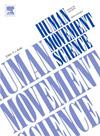Expansion of perceived passable width in older adults
IF 1.9
3区 心理学
Q4 NEUROSCIENCES
引用次数: 0
Abstract
Humans can perceive whether an aperture is passable; this ability is known as passable width perception. Previous studies have shown that passable width in older adults is larger when walking and suggested the effect of larger body sway in older adults while walking on passable width expansion. However, no studies have directly investigated this. Thus, the present study conducted two experiments to investigate the effect of body instability on passable width perception in young and older adults. In Experiment 1, young and older adult participants kept standing upright with their feet together (i.e., Romberg stance) or with their feet in line (i.e., Tandem stance) while observing various aperture widths presented on a large display at a distance of 3 m. The participants were required to judge whether the aperture was passable without turning their shoulders. During the task, body sway was measured using a motion capture device. The results showed larger sway in the Tandem stance than in the Romberg stance, irrespective of age group; however, a change in perceived passable width was observed only in older adults: it expanded in the unstable condition compared to the stable condition. In Experiment 2, the young adults performed the same task with a more unstable stance (i.e., one-leg standing) than that adopted in Experiment 1. Nevertheless, it did not affect their passable width perception. These results suggest that only older adults exploit the online status of their body sway to estimate their safety margins even during a non-walking situation. Future studies on passable width perception are expected to measure body sway.
老年人感知可通过宽度的扩大。
人类可以感知光圈是否可以通过;这种能力被称为可通过宽度感知。以往的研究表明,老年人行走时的可通过宽度更大,这表明老年人行走时较大的身体摆动对可通过宽度的扩展有影响。然而,没有研究直接调查过这一点。因此,本研究通过两个实验来探讨身体不稳定性对年轻人和老年人可通过宽度感知的影响。在实验1中,青年和老年被试分别保持双脚并拢站立(Romberg站立)或双脚成直线站立(Tandem站立),同时观察距离3 m的大屏幕上显示的各种孔径宽度。参与者被要求在不转动肩膀的情况下判断光圈是否可以通过。在这项任务中,身体摆动是用动作捕捉设备测量的。结果表明,无论年龄组,串联体位的摇摆幅度大于Romberg体位;然而,仅在老年人中观察到感知可通过宽度的变化:与稳定条件相比,不稳定条件下可通过宽度扩大。在实验2中,年轻成人以比实验1更不稳定的站立姿势(即单腿站立)完成相同的任务。然而,这并不影响他们对及格宽度的感知。这些结果表明,即使在不走路的情况下,也只有老年人利用他们身体摇摆的在线状态来估计他们的安全边际。未来对可通过宽度感知的研究有望测量身体摇摆。
本文章由计算机程序翻译,如有差异,请以英文原文为准。
求助全文
约1分钟内获得全文
求助全文
来源期刊

Human Movement Science
医学-神经科学
CiteScore
3.80
自引率
4.80%
发文量
89
审稿时长
42 days
期刊介绍:
Human Movement Science provides a medium for publishing disciplinary and multidisciplinary studies on human movement. It brings together psychological, biomechanical and neurophysiological research on the control, organization and learning of human movement, including the perceptual support of movement. The overarching goal of the journal is to publish articles that help advance theoretical understanding of the control and organization of human movement, as well as changes therein as a function of development, learning and rehabilitation. The nature of the research reported may vary from fundamental theoretical or empirical studies to more applied studies in the fields of, for example, sport, dance and rehabilitation with the proviso that all studies have a distinct theoretical bearing. Also, reviews and meta-studies advancing the understanding of human movement are welcome.
These aims and scope imply that purely descriptive studies are not acceptable, while methodological articles are only acceptable if the methodology in question opens up new vistas in understanding the control and organization of human movement. The same holds for articles on exercise physiology, which in general are not supported, unless they speak to the control and organization of human movement. In general, it is required that the theoretical message of articles published in Human Movement Science is, to a certain extent, innovative and not dismissible as just "more of the same."
 求助内容:
求助内容: 应助结果提醒方式:
应助结果提醒方式:


